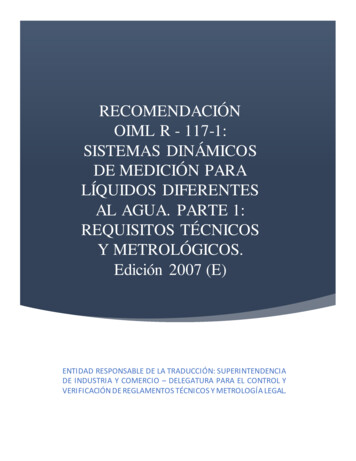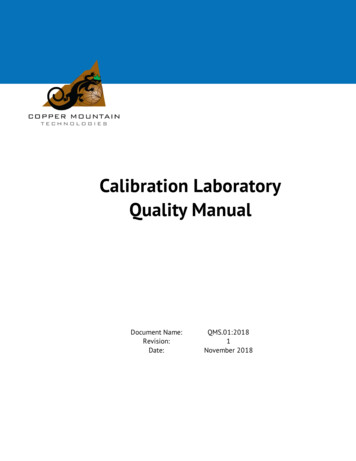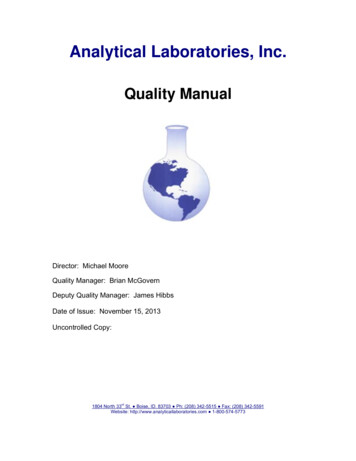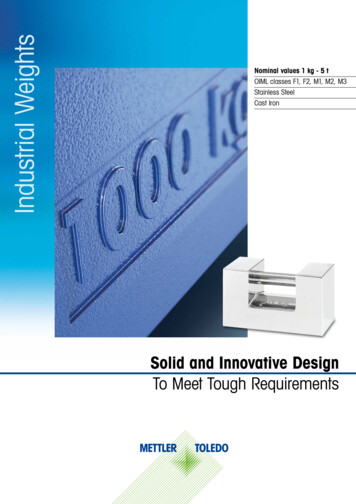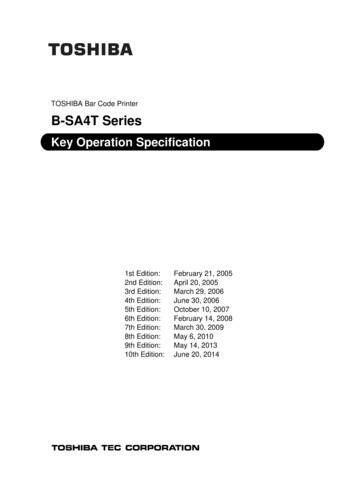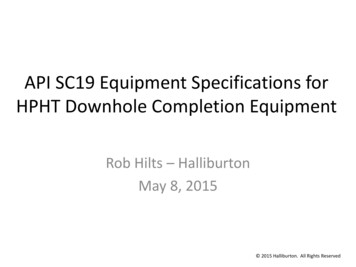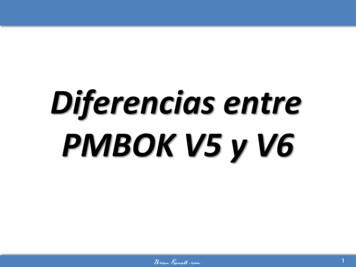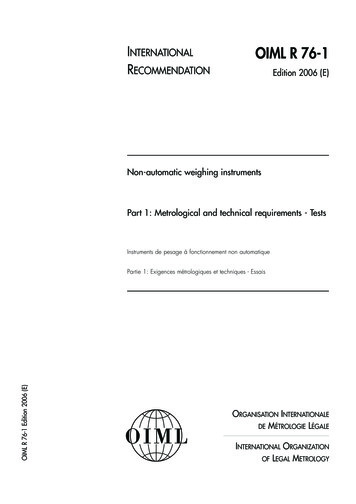
Transcription
INTERNATIONALRECOMMENDATIONOIML R 76-1Edition 2006 (E)Non-automatic weighing instrumentsPart 1: Metrological and technical requirements - TestsInstruments de pesage à fonctionnement non automatiqueOIML R 76-1 Edition 2006 (E)Partie 1: Exigences métrologiques et techniques - EssaisORGANISATION INTERNATIONALEDE MÉTROLOGIE LÉGALEINTERNATIONAL ORGANIZATIONOF LEGAL METROLOGY
OIML R 76-1: 2006 (E)CONTENTSForeword .4TT.1T.2T.3T.4T.5T.6T.7T.8T.9Terminology .5General definitions.5Construction of an instrument.7Metrological characteristics of an instrument .13Metrological properties of an instrument .15Indications and errors.15Influences and reference conditions.20Performance test .20Index of terms defined .21Abbreviations and symbols.231Scope .2522.12.22.32.42.5Principles of the Recommendation .25Units of measurement .25Principles of the metrological requirements.25Principles of the technical requirements .25Application of requirements .26Terminology .2633.13.23.33.43.53.63.73.83.93.10Metrological requirements .26Principles of classification .26Classification of instruments.27Additional requirements for multi-interval instruments.27Auxiliary indicating devices .28Maximum permissible errors .30Permissible differences between results.31Test standards .32Discrimination .32Variations due to influence quantities and time .33Type evaluation tests and 14.124.134.144.154.164.174.184.194.20Technical requirements for a self- or semi-self-indicating instrument.41General construction requirements .41Indication of weighing results.43Analog indicating devices.45Digital indicating devices .46Zero-setting and zero-tracking devices .47Tare devices.49Preset tare devices.53Locking positions.53Auxiliary verification devices (removable or fixed) .54Selection of weighing ranges on a multiple range instrument.54Devices for selection (or switching) between various load receptors and/or load transmitting devicesand various load measuring devices.54“Plus and minus” comparator instruments .55Instruments for direct sales to the public .55Additional requirements for price-computing instruments for direct sales to the public .57Instruments similar to those normally used for direct sales to the public.59Price-labeling instruments .59Mechanical counting instruments with unit-weight receptor .59Additional technical requirements for mobile instruments .59Portable instruments for weighing road vehicles .60Modes of operation .6155.15.25.35.45.5Technical requirements for electronic instruments .61General requirements.61Acting upon significant faults .62Functional requirements .62Performance and span stability tests .63Additional requirements for software-controlled electronic devices.646Technical requirements for non-self-indicating instruments.692
OIML R 76-1: 2006 (E)6.16.26.36.46.56.66.76.86.9Minimum sensitivity .70Acceptable solutions for indicating devices.70Conditions of construction.71Simple equal arm beam.72Simple 1/10 ratio beam .72Simple sliding poise instruments (steelyards) .73Roberval and Béranger instruments .74Instruments with ratio platforms .74Instruments with a load-measuring device having accessible sliding poises (of the steelyard type).7577.17.2Marking of instruments and modules.76Descriptive markings .76Verification marks .7988.18.28.38.4Metrological controls.80Liability to metrological controls.80Type approval .80Initial verification .82Subsequent metrological control.83Annex A Testing procedures for non-automatic weighing instruments .85A.1Administrative examination.85A.2Compare construction with documentation.85A.3Initial examination .85A.4Performance tests.85A.5Influence factors .94A.6Endurance test.97Annex B Additional tests for electronic instruments.100B.1General requirements for electronic instruments under test.100B.2Damp heat, steady state .100B.3Performance tests for disturbances .101B.4Span stability test.106Annex C Testing and certification of indicators and analog data processing devices as modulesof non-automatic weighing instruments.108C.1Applicable requirements .108C.2General principles of testing .109C.3Tests.112C.4OIML Certificates.116Annex D Testing and certification of digital data processing devices, terminals and digital displaysas modules of non-automatic weighing instruments .118D.1Applicable requirements .118D.2General principles of testing .119D.3Tests.119D.4OIML Certificates.120Annex E Testing and certification of weighing modules as modules of non-automatic weighing instruments.122E.1Applicable requirements .122E.2General principles of testing .123E.3Tests.123E.4OIML Certificates.124Annex F Compatibility checking of modules of non-automatic weighing instruments.126F.1Weighing instrument.126F.2Separately tested load cells .127F.3Separately tested indicators and analog data processing devices .129F.4Compatibility checks for modules with analog output.130F.5Compatibility checks for modules with digital output .132F.6Examples of compatibility checks for modules with analog output.132Annex G Additional examinations and tests for software-controlled digital devices and instruments .137G.1Devices and instruments with embedded software .137G.2Personal computers and other devices with programmable or loadable software .137G.3Data storage devices .138G.4Test Report Format .139Bibliography.1403
OIML R 76-1: 2006 (E)ForewordThe International Organization of Legal Metrology (OIML) is a worldwide, intergovernmentalorganization whose primary aim is to harmonize the regulations and metrological controls applied bythe national metrological services, or related organizations, of its Member States. The main categoriesof OIML publications are: International Recommendations (OIML R), which are model regulations that establish themetrological characteristics required of certain measuring instruments and which specifymethods and equipment for checking their conformity. OIML Member States shall implementthese Recommendations to the greatest possible extent; International Documents (OIML D), which are informative in nature and which areintended to harmonize and improve work in the field of legal metrology; International Guides (OIML G), which are also informative in nature and which areintended to give guidelines for the application of certain requirements to legal metrology; and International Basic Publications (OIML B), which define the operating rules of the variousOIML structures and systems.OIML Draft Recommendations, Documents and Guides are developed by Technical Committees orSubcommittees which comprise representatives from the Member States. Certain international andregional institutions also participate on a consultation basis. Cooperative agreements have beenestablished between the OIML and certain institutions, such as ISO and the IEC, with the objective ofavoiding contradictory requirements. Consequently, manufacturers and users of measuringinstruments, test laboratories, etc. may simultaneously apply OIML publications and those of otherinstitutions.International Recommendations, Documents, Guides and Basic Publications are published in English(E) and translated into French (F) and are subject to periodic revision.Additionally, the OIML publishes or participates in the publication of Vocabularies (OIML V) andperiodically commissions legal metrology experts to write Expert Reports (OIML E). ExpertReports are intended to provide information and advice, and are written solely from the viewpoint oftheir author, without the involvement of a Technical Committee or Subcommittee, nor that of theInternational Committee of Legal Metrology. Thus, they do not necessarily represent the views of theOIML.This publication - reference OIML R 76-1, Edition 2006 - was developed by Technical SubcommitteeTC 9/SC 1 Non-automatic weighing instruments. It was approved for final publication by theInternational Committee of Legal Metrology in 2006 and will be submitted to the InternationalConference of Legal Metrology in 2008 for formal sanction. It supersedes the previous edition ofR 76-1 (1992).OIML Publications may be downloaded from the OIML web site in the form of PDF files. Additionalinformation on OIML Publications may be obtained from the Organization’s headquarters:Bureau International de Métrologie Légale11, rue Turgot - 75009 Paris - FranceTelephone:33 (0)1 48 78 12 82Fax:33 (0)1 42 82 17 27E-mail:biml@oiml.orgInternet:www.oiml.org4
OIML R 76-1: 2006 (E)TERMINOLOGY(terms, definitions and references)The terminology used in this Recommendation conforms to the “International Vocabulary of Basicand General Terms in Metrology” (VIM) [1], the “International Vocabulary of Terms in LegalMetrology” (VIML) [2], the “OIML Certificate System for Measuring Instruments” [3] and otherrelevant OIML publications. In addition, for the purposes of this Recommendation, the followingdefinitions apply. An index of all the terms, definitions and references defined below can be foundunder T.8.T.1General definitionsT.1.1Weighing instrumentMeasuring instrument that serves to determine the mass of a body by using the action of gravity onthis body.Note:In this Recommendation “mass” (or “weight value”) is preferably used in the sense of“conventional mass” or “conventional value of the result of weighing in air” according toR 111 and D 28, whereas “weight” is preferably used for an embodiment (i.e. materialmeasure) of mass that is regulated in regard to its physical and metrological characteristics.The instrument may also be used to determine other quantities, magnitudes, parameters orcharacteristics related to the determined mass.According to its method of operation, a weighing instrument is classified as an automatic weighinginstrument or a non-automatic weighing instrument.T.1.2Non-automatic weighing instrumentInstrument that requires the intervention of an operator during the weighing process to decide that theweighing result is acceptable.Note 1: Deciding that the weighing result is acceptable includes any intelligent action by the operatorthat affects the result, such as taking an action when an indication is stable or adjusting themass of the weighed load, and to make a decision regarding the acceptance of each weighingresult on observing the indication or releasing a print out. A non-automatic weighing processallows the operator to take an action (i.e. adjust the load, adjust the unit price, determine thatthe load is acceptable, etc.) which influences the weighing result in the case where theweighing result is not acceptable.Note 2: In case of doubt as to whether an instrument is a non-automatic weighing instrument or anautomatic weighing instrument, the definitions for automatic weighing instruments given inOIML Recommendations R 50, R 51, R 61, R 106, R 107 and R 134 have higher prioritythan the criteria of Note 1 above.A non-automatic weighing instrument may be: graduated or non-graduated; or self-indicating, semi-self-indicating or non-self-indicating.Note:T.1.2.1In this Recommendation a non-automatic weighing instrument is called an “instrument”.Graduated instrumentInstrument allowing the direct reading of the complete or partial weighing result.5
OIML R 76-1: 2006 (E)T.1.2.2Non-graduated instrumentInstrument not fitted with a scale numbered in units of mass.T.1.2.3Self-indicating instrumentInstrument in which the position of equilibrium is obtained without the intervention of an operator.T.1.2.4Semi-self-indicating instrumentInstrument with a self-indicating weighing range, in which the operator intervenes to alter the limits ofthis range.T.1.2.5Non-self-indicating instrumentInstrument in which the position of equilibrium is obtained entirely by the operator.T.1.2.6Electronic instrumentInstrument equipped with electronic devices.T.1.2.7Instrument with price scalesInstrument that indicates the price to pay by means of price charts or scales related to a range of unitprices.T.1.2.8Price-computing instrumentInstrument that calculates the price to pay on the basis of the indicated weight value and the unit price.T.1.2.9Price-labeling instrumentPrice-computing instrument that prints the weight value, unit price and price to pay for prepackages.T.1.2.10Self-service instrumentInstrument that is intended to be operated by the customer.T.1.2.11Mobile instrumentNon-automatic weighing instrument mounted on or incorporated into a vehicle.Note 1: A vehicle-mounted instrument is a complete weighing instrument which is firmly mountedon a vehicle, and which is designed for that special purpose.Example: Postal scale mounted on a vehicle (mobile post office).Note 2: A vehicle-incorporated instrument uses parts of the vehicle for the weighing instrument.Examples: Garbage weighers, patient lifters, pallet lifters, fork lifters, wheel chairweighers.T.1.2.12Portable instrument for weighing road vehiclesNon-automatic weighing instrument having a load receptor, in one or several parts, which determinesthe total mass of road vehicles, and which is designed to be moved to other locations.Examples:Portable weighbridge, group of associated non-automatic axle (or wheel) load weighers.6
OIML R 76-1: 2006 (E)Note:This Recommendation covers only weighbridges and groups of associated non-automaticaxle (or wheel) load weighers that determine simultaneously the total mass of a road vehiclewith all axles (or wheels) being simultaneously supported by appropriate parts of a loadreceptor.T.1.2.13Grading instrumentInstrument which assigns a weighing result to a predetermined range of mass to determine a tariff ortoll.Examples:T.1.3Postal scales, garbage weighers.Indications of an instrumentValue of a quantity provided by a measuring instrument.Note:T.1.3.1“Indication”, “indicate” or “indicating” includes both displaying and/or printing.Primary indicationsIndications, signals and symbols that are subject to requirements of this Recommendation.T.1.3.2Secondary indicationsIndications, signals and symbols that are not primary indications.T.2Construction of an instrumentIn this Recommendation the term “device” is used for any means by which a specific function isperformed, irrespective of the physical realization, e.g. by a mechanism or a key initiating anoperation. The device may be a small part or a major portion of an instrument.T.2.1Main devicesT.2.1.1Load receptorPart of the instrument intended to receive the load.T.2.1.2Load-transmitting devicePart of the instrument for transmitting the force produced by the load acting on the load receptor to theload-measuring device.T.2.1.3Load-measuring devicePart of the instrument for measuring the mass of the load by means of an equilibrium device forbalancing the force coming from the load transmitting device, and an indicating or printing device.T.2.2ModuleIdentifiable part of an instrument that performs a specific function or functions, and that can beseparately evaluated according to specific metrological and technical performance requirements in therelevant Recommendation. The modules of a weighing instrument are subject to specified partial errorlimits.Note:Typical modules of a weighing instrument are: load cell, indicator, analog or digital dataprocessing device, weighing module, terminal, primary display.7
OIML R 76-1: 2006 (E)Independent OIML Certificates according to R 76 can be issued for the modules mentioned in T.2.2.2T.2.2.7.Figure 1Definition of typical modules according to T.2.2 and 3.10.2(other combinations are possible)Analog load cell(T.2.2.1)2Digital load cell(T.2.2.1)2 Indicator(T.2.2.2)Analog data processing device(T.2.2.3)Digital data processing device(T.2.2.4)Terminal(T.2.
T.1.2.3 Self-indicating instrument . Instrument in which the position of equilibrium is obtained without the intervention of an operator. T.1.2.4 Semi-self-indicating instrument . Instrument with a self-indicating weighing range, in which the operator intervenes to alter the limits of this range. T.1.2.5 Non-self-indicating instrument
